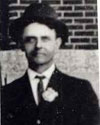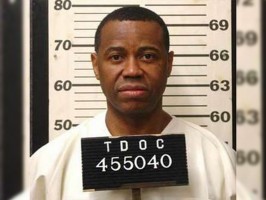Shots rang out from the dark on Halloween night 1911 in Shelbyville, striking two Bedford County lawmen dead.
Earlier in the afternoon deputies had arrested a man for drunkeness and placed him in the Shelbyville city workhouse. The man was released the same day on bond and vowed revenge against the men who put him in jail.
Around 9 p.m. Oct. 31, 1911, vengeance was had. According to one newspaper account, "Shelbyville has never had in her 100 years' existence a tragedy that has so stirred up her citizens."
But was the man believed to have shot the officers the true perpetrator?
He claimed he was visiting his paramour when the crime occurred.
Within days, the people of Shelbyville and the state had raised $1,000 in reward money to search out the man responsible for "the atrocious crime."
Did the money influence the arrest? More than 100 years later, these questions still linger.
The Victims
 Redin G. Purdy, who "was highly esteemed" had worked as the superintendent of the Bedford County home for the poor before becoming a police officer. He was survived by a wife and two married daughters.
Redin G. Purdy, who "was highly esteemed" had worked as the superintendent of the Bedford County home for the poor before becoming a police officer. He was survived by a wife and two married daughters.
A native of Bell Buckle, Charles Henry (pictured here) was survived by a wife and five young children, two of which were suffering from typhoid at the time of his death.
The Crime
Around 5:30 p.m. Oct. 31, 1911, Officers Redin G. Purdy and Rittenberry (no first name given) arrested Marion E. Anderson on a charge of being drunk and disorderly, as well as attempted assault of an officer. Anderson reportedly attacked Rittenberry with a knife and kept him from drawing his service revolver.
Anderson made bond after an appearance in Shelbyville city court and was released later that evening.
According to witnesses, Anderson said he intended to shoot the two officers who arrested him.
The perpetrator hid himself about 150 feet away behind the doorpost of a neighboring meat shop that was "lighted by eletric light." As the lawmen walked down Depot Street, shots were fired and Purdy was shot in the left chest and right arm. He died in the street. Henry was also shot and died shortly afterward.
The only witnesses didn't see the shooting but saw a man flee on a yellow horse along Wartrace Pike.
The Suspect
 The 35-year-old Marion E. Anderson was described as standing 5'9" and weighing 155 pounds with dark hair and brown eyes. He "was clean-shaven on the night of the murder" and had a "heavy upper lip, two front teeth badly decayed, one being almost entirely gone."
The 35-year-old Marion E. Anderson was described as standing 5'9" and weighing 155 pounds with dark hair and brown eyes. He "was clean-shaven on the night of the murder" and had a "heavy upper lip, two front teeth badly decayed, one being almost entirely gone."
Anderson consistently proclaimed his innocence throughout his trial. He also claimed Purdy and Henry as friends.
"He said that he had been advised to get out of the county, even out of the United States, but as he was not guilty of the crime, he had no reason to run away," according to an article from Jan. 6, 1912, in The Nashville Tennessean and American.
During the trial, it was revealed that Anderson had both a wife and a girlfriend.
In 1909, Tennessee became the first state in the nation to pass laws making it illegal to buy or sell alcohol or "spirituous liquors" within four miles of any school in the state. Offenders faced a misdemeanor charge and fines if caught.
In Shelbyville, there was at least one establishment that was "notorious as a resort of the bootlegging element." That place was the livery stable on Depot Street in Shelbyville, Marion E. Anderson, proprietor.
The Investigation
The investigation started immediately with officers looking high and low for Anderson.
According to one report on Nov. 8, 1911, from The Nashville Banner, a $1,000 reward (more than $25,000 today) was being offered with the town of Shelbyville, Bedford County Sheriff's Office and Tennessee Gov. Ben W. Hooper all contributing to the cause. Anderson was wanted dead or alive.
He was believed to be hiding "in the Barrens near his old home at Baucom in Coffee County" because his horse was found there Nov. 1, 1911. Baucom is in between Beech Grove and Manchester on Highway 41 South.
Search parties numbering more than 300 men with bloodhounds combed the countryside for Anderson.
It took two months, but Anderson was eventually apprehended and placed on trial in Bedford County.
He was found 12 miles from Shelbyville near the Cannon and Coffee county line hiding in a smokehouse owned by his attorney.
After getting a tip, Bedford County Sheriff James "Big Jim" Williams gathered a posse of three officers and a special deputy. They traveled to the hideout where they found Anderson in the smokehouse talking to former Bedford County Sheriff William G. Rucker and another man. Williams served Anderson an arrest warrant and took the fugitive into custody.
Anderson went quietly except a request to visit his family before he was taken to Nashville "for safe keeping."
Rucker said he was tipped off the day before about Anderson's location and went to take the man into custody. He then apprehended Anderson and put him in an outhouse until better accommodations could be found.
This was disagreement over who was responsible for the arrest meant the men disagreed over who deserved the $1,000 reward.
The Trial
The first trial of Marion Anderson began April 15, 1912, as he was tried for the shooting death of Redin G. Purdy. It took a judge from Rutherford County, three days and 500 men to chose a jury of 12 for the trial to begin. The trial for the death of Charles Henry was slated for June 1912.
When Judge John E. Richardson of Murfreesboro started the trial, the courtroom was packed with onlookers and a force of 40 police officers in the streets in case of riot. According to news reports, rain had kept the farmers for the field, so they came to the courthouse to watch the proceedings.
One of the state's first witnesses, Anderson's cousin S.M. Rayburn testified he was working at Anderson's livery stable on the night of the shooting.
Rayburn said Anderson returned drunkenly to the stable around 8 p.m. with two other men before Anderson saddled a light yellow horse.
During his saddling of the horse Rayburn testified he heard Anderson declare that he would shoot the officers. In response, one of the other men urged Anderson to sleep it off, but he refused, hitched his horse to a post and walked out into the night.
"Within three minutes after Anderson left the stable, Rayburn declared that he heard shots fired and in a few seconds later Anderson reappeared, running down the street," one news report of the trial said.
Anderson, pistol in hand, jumped on his horse and yelled "I got 'em both" as he rode out of town," Rayburn testified.
Another witness testified that Anderson hid in a corn crib the day after the shooting and tried to mask his scent with turpentine.
On the second day of the trial, the coroner testified to Purdy's injuries and the victim's bloody clothing was admitted into evidence before Anderson took the stand in his own defense.
Anderson testified that he had been at a pool hall the day of the shooting "and was very drunk" when Purdy and Rittenberry arrested him for drunkeness. On the way to the jail, Anderson said Rittenberry struck him with a club in the ribs.
After posting bail, Anderson said he saddled his horse, so he could ride out to visit his father and then walked to see his paramour. On his way back to the stable, he heard of the shooting and that he was the prime suspect, Anderson testified. That was why he fled and hid.
Then Anderson claimed he was framed because of the size of the reward.
The defense also claimed a principal witness had been paid off by the town of Shelbyville not to testify.
After a three-day trial, the jury deliberated two days as to Anderson's guilt and the sentence to be given to him. On April 20, 1912, the jury found Anderson guilty of second-degree murder and sentenced him to 20 years in prison for the shooting death of Purdy.
Anderson was again taken to Nashville to protect him from lynching.
For the second trial, which began at the end of June 1912, 1,500 potential jurors were called in and to be narrowed down to 12. But before the trial could begin, Anderson entered a guilty plea in the murder of Charles Henry and was sentenced to 20 years to be served consecutively.










